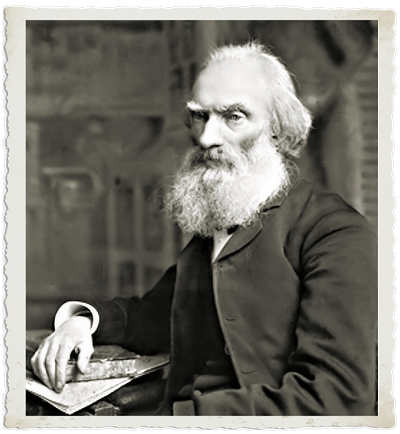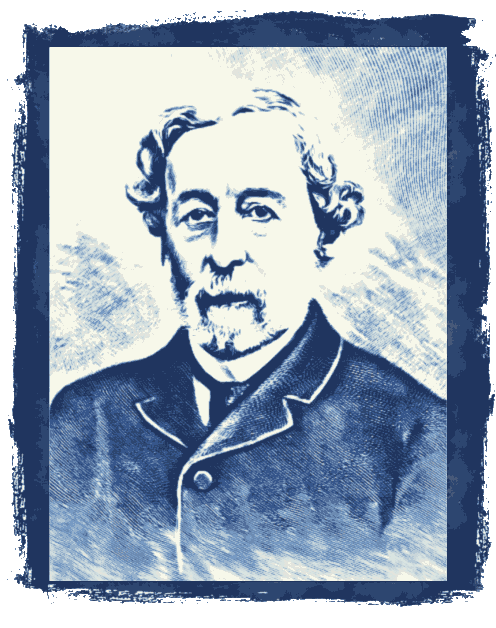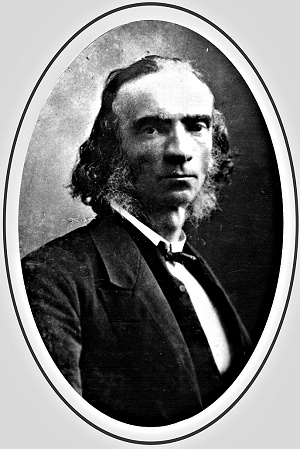|
The Zero Anthropology Project
Webfolio for Maximilian C. Forte 
HOME |
SITE MAP |
ABOUT
| RESEARCH |
MEDIA |
ARTICLES |
REVIEWS |
COURSES |
ZAP SITES |
CONTACT



This is an edited and abridged version of an an
article that
appeared on
Zero Anthropology.
 When
it comes to anthropology, Canada is the home of
a number of “firsts”. The first courses
in anthropology offered in any university in the
world, were offered in Canada: they were taught
by
Sir Daniel Wilson at the
University of Toronto (Van Esterik, 2006, p.
261)—in the photo at right. Daniel Wilson was
also the world’s first professional,
university-based anthropologist (Hancock, 2006,
p. 36). The first PhD in Anthropology in all of
North America was earned by A.F. Chamberlain, a
Canadian (Cole, 1973, p. 40). When
it comes to anthropology, Canada is the home of
a number of “firsts”. The first courses
in anthropology offered in any university in the
world, were offered in Canada: they were taught
by
Sir Daniel Wilson at the
University of Toronto (Van Esterik, 2006, p.
261)—in the photo at right. Daniel Wilson was
also the world’s first professional,
university-based anthropologist (Hancock, 2006,
p. 36). The first PhD in Anthropology in all of
North America was earned by A.F. Chamberlain, a
Canadian (Cole, 1973, p. 40).
 Sir
Daniel Wilson—as Canada’s and the world’s first
university-based professional whose teaching,
research, and writing focused on explicitly
anthropological topics—was responsible for first
developing the very topics of Canadian
anthropological study. Both Wilson, and then
Horatio Hale (portrait, left)
soon after, pioneered an intellectual tradition
that was in some ways a precursor to what
developed later in the US (thanks to Franz Boas
who worked under Hale in Canada), but also
remained relatively unique. Sir
Daniel Wilson—as Canada’s and the world’s first
university-based professional whose teaching,
research, and writing focused on explicitly
anthropological topics—was responsible for first
developing the very topics of Canadian
anthropological study. Both Wilson, and then
Horatio Hale (portrait, left)
soon after, pioneered an intellectual tradition
that was in some ways a precursor to what
developed later in the US (thanks to Franz Boas
who worked under Hale in Canada), but also
remained relatively unique.
One can only guess what Canadian anthropology
would have been, had there been continuity in
development building on the foundations laid by
Wilson and Hale. We might be exactly where we
are today, where anthropology in Canada is
largely an import shaped by professionals who
were either trained in the US or the UK, and
where many of the teaching materials are
similarly imported. Another possibility is that
Canadian anthropology would have been present in
universities, but not as a distinct discipline
that occupied space in the form of departments.
This essay builds on the second vein.
Theoretical Foundations of a Canadian
Anthropology
Some of the key theoretical developments common
to Wilson and Hale include: a non-racist
and a non-linear theory of cultural
change; cultural relativism; and, a multi-field
approach (that included linguistics and
archaeology). In addition, the Canadians were
deeply embedded in public communications, would
frequently address public audiences at schools,
libraries, museums, or in the press, and in this
sense they innovated a form of “public
anthropology” before the phrase even existed.
Neither of them practiced anthropology as a
“discipline”: at the University of Toronto,
courses in ethnology were offered in a variety
of programs, while Hale did not work in a
university setting.
If we were to summarize their innovations, we
would have the following as a rough list:
-
The term “prehistory” was first coined by
Daniel Wilson (Cole, 1973, pp. 33, 35).
-
Daniel Wilson did not accept the idea of
either unilineal or unidirectional evolution
(Trigger, 1966, p. 13); Hale; rejected
evolutionary stage theory (Cole, 1973, p.
39).
-
Daniel Wilson argued that it was possible
for a society to pass from a more advanced
to a more primitive state, thus breaking
with the teleology of cultural evolutionism
(Trigger, 1966, p. 13). Things could indeed
fall apart.
-
Daniel Wilson rejected the theory that one
could explain cultural and even linguistic
differences in terms of racial variation
(Trigger, 1966, p. 21).
-
Daniel Wilson demonstrated that cranial
capacity did not provide a gauge of
intellectual capacity, countering the
assumptions of early physical anthropology
(Cole, 1973, p. 35).
-
Daniel Wilson argued that “primitive
peoples” have the same intellectual
capacities as “civilized” peoples, “and he
refused to consider the state of a culture’s
development to be an indication of the
intellectual ability of its members”
(Trigger, 1966, p. 12).
-
What came to be known elsewhere as “cultural
relativism” was developed first in Canada,
in the works of both Wilson and Hale
(Trigger, 1966, p. 14; Cole, 1973, p. 39).
-
There was a strong critique of racism as
found in the American School of Ethnology,
by Daniel Wilson (Trigger, 1966, p. 15);
Horatio Hale likewise criticized
ethnocentric prejudice, at a time when such
prejudice was a foundation of British and US
ethnology (Cole, 1973, p. 39).
 One
might speculatively extrapolate from these
foundations. To begin, their rejection of
the kind of progressivist, liberal, “cultural
evolutionism” that has dominated mainstream
political and economic thought in North America,
would have directed Canadian anthropology to
reject modernization theory and neoliberalism.
Canadian anthropology would have had nothing to
do with “development studies”. Canadian
anthropology would have been equally inclined to
reject “peace-building,” the “responsibility to
protect,” “humanitarian intervention,” and
“democracy promotion”—key ideological supports
for imperialist policies of regime change and
de facto recolonization. One
might speculatively extrapolate from these
foundations. To begin, their rejection of
the kind of progressivist, liberal, “cultural
evolutionism” that has dominated mainstream
political and economic thought in North America,
would have directed Canadian anthropology to
reject modernization theory and neoliberalism.
Canadian anthropology would have had nothing to
do with “development studies”. Canadian
anthropology would have been equally inclined to
reject “peace-building,” the “responsibility to
protect,” “humanitarian intervention,” and
“democracy promotion”—key ideological supports
for imperialist policies of regime change and
de facto recolonization.
Paternalistic and ethnocentric approaches to
international affairs, which involve the “most
developed” extending a “helping hand” to speed
up the “least developed” in “bridging” the “gap”
in consumption, governance, and so on—would have
been tossed out by Canadian anthropology, at the
very least for being unscientific. Likewise, the
notion of “American exceptionalism” would have
been torn asunder by Canadian anthropology. It
is fundamentally an expression of progressivist,
ethnocentric prejudice.
Second, Canadian anthropology would not
have allowed for the race-fixation that has
become dominant in the US. The incessant
racialization of analysis of social relations
would thus have found no fertile ground for
development in Canadian anthropology, nor the
competitive identity politics that play a
central role in neocolonial/neoliberal
divide-and-rule strategies.
Third, Canadian anthropology would not
have developed separate from other
disciplines—since it would not have been a
discipline itself. It would have instead become
a fertile field for combining the methods and
insights of a wide range of intellectual
endeavours, all driven by a basic aim of
explaining how human societies come together in
given places and times, how they cohere and fall
apart, and how members of many different
national societies interact in creating new
societies. Hale, and Wilson especially, were
interested in issues of cultural
transplantation, hybridization, and demographic
migration—the kinds of large-scale processes
that have historically been brought about as a
result of the work of empire.

“what kind of anthropology is there,
that is even worth having?”
The
questions, the topics, the concerns would have
been of the “biggest” kind, particularly
following Wilson—anthropology would have leaned
more toward the nomothetic side (for
more, see
this and
the other article on the ZAP site).
Certainly the study of empire would have
been particularly welcome in a Canadian
anthropology that was interested in
understanding and explaining the forces at work
in shaping human lives, human social orders, and
human futures. Imperialism has been the
largest-scale force responsible for undoing,
repacking, and reinventing societies, how they
are governed, what they produce and why they
produce certain products, and for significantly
affecting the quality of human lives. Without
such an interest, what kind of anthropology is
there that is even worth having?
The Parameters of a Canadian Anthropology
The
shape of Canadian anthropology, on the
foundations laid by Daniel Wilson, had at least
the six following, and very notable features:
-
Multi-disciplinarity: Canadian
anthropology did not originate as an
independent discipline in universities. It
was always, from its earliest beginnings,
part of a field of inquiry conducted by
persons in multiple disciplines. Even when
institutionalized in universities, Canadian
anthropology was housed in
multi-disciplinary schools of social
science, and to this day about a third of
all anthropology programs in Canada remain
wed to sociology.
-
Public communication: Wilson, Hale,
and their contemporaries saw their teaching
mission as extending to public lectures in
schools, museums, and seminaries. They
sought out the press. This was done as if a
normal part of the routine, which upsets any
preconception of the Canadian university as
either always or only an “ivory tower”
institution. Canadian anthropology was a
public mission.
-
History—the Long-Term: Wilson’s work
shows a keen interest in grasping large
sweeps of time, in seeing cycles where
others saw unidirectional progress. This
interest in rise and fall is also
well suited to the study of empires.
-
Large spaces, large movements—the
Large-Scale: Wilson’s focus on the
encounters of large masses of different
peoples, brought from different continents,
complimented his interest in long time
frames.
-
No kinship: Kinship was not a subject
of concern to Wilson. Instead, as was
convincingly explained by
Adam Kuper, the
lead historian of British anthropology,
kinship took shape as a subject of concern
to a particular, Victorian English social
class. There is nothing “universal” about
the origins or applicability of this
interest.
-
Independent of the US: Wilson asked
his own questions, and developed his own
ways for answering them. This was done by
remaining largely out of communication with
US and European anthropology.
From the above, we can distil a number of key
lessons for the development of an intellectually
independent, non- or anti-imperial Canadian
anthropology.
Practical Foundations for the (Re)Development of
a Canadian Anthropology
We
know a number of things about the working lives
of Daniel Wilson and Horatio Hale, that would
seem to furnish clues about their intellectual
development. For example:
-
Wilson particularly, and to some extent
Hale, either had strained or distant
relationships with their US counterparts
(Trigger, 1966, pp. 23, 26).
-
There was, at best, a remote connection to
European intellectual currents of the time
(Trigger 1966, p. 23).
We
are essentially dealing with two issues:
localization and innovation,
occurring together. How can this be achieved?
From the examples of Wilson and Hale, the
following interpretations might provide some
guidance:
(A) Distance from origins: though both
Wilson and Hale were schooled in Europe and the
US respectively, they also grew apart from those
original experiences, with both time and
distance, until they were no longer in the
mainstream of circulating currents in those
places.
(B) Filtered memories: with time, what
was once very influential in one’s intellectual
formation, can become rarely revisited sediment,
or it can even be lost.
(C) Aberrant mutations: mutations perform
a vital role in any evolutionary process. There
can be epistemic mutations as well, that thrive
in isolation, especially given free space in
which to grow. Dialogue is very important, but
so is a period of silence. Silence can perform a
role similar to radioactivity, in transforming
ideas that were barely held consciously and
which suddenly come to the fore in a new shape.
(D) Relative isolation: neither Wilson
nor Hale were formed in isolation from the
centres of learning. However, they both matured
in later years apart from such centres. This may
not have caused them to think
independently, but it was certainly present in
the process.
(E) Instability, chaos, upheaval: both
Wilson and Hale underwent some difficult
separations and transitions, finding themselves
in unfamiliar surroundings, far from home, yet
making a new home for themselves. Hale married a
Canadian, integrated into his community, and
immersed himself in local research. Wilson’s
mind shifted from Scotland to Aboriginal North
America. Their life experience would have taught
them to take little for granted and to see
stability as only momentary and fragile. Such
life experiences work against the ossification
of thought, against the comforts of hegemonic
knowledge, against disciplinary doxa.
(F) Charismatic idiosyncrasy: to fashion
a new program of teaching and research, to give
it both institutional form and make it a subject
of public fascination, requires a certain amount
of courage. Published research on Wilson and
Hale frequently alludes to their idiosyncratic
qualities, the strong nature of their individual
personas, and their tendency to launch
themselves into the public arena as educators.

“a Canadian anthropological approach
to
the study of empire and the human condition”
Hopefully, with what has been outlined above, it
might now be clearer why the “slogan” of Zero
Anthropology is, “a Canadian anthropological
approach to the study of empire and the human
condition”. Another way of seeing it is, in the
wry words of a colleague: “a tradition that
isn’t one”.
References
Cole, Douglas. (1973). “The Origins of Canadian
Anthropology, 1850-1910”. Journal of Canadian
Studies, 8, 33–45.
Forte, Maximilian C. (2017). “Canada,
First in Anthropology”. Zero
Anthropology, July 3.
————— . (2014). “Anthropology:
The Empire on which the Sun Never Sets (Part 1)”. Zero
Anthropology, May 16.
Hancock, Robert L.A. (2006). “Toward a
Historiography of Canadian Anthropology”. In
Julia Harrison & Regna Darnell, (Eds.),
Historicizing Canadian Anthropology (pp.
30–43). Vancouver: UBC Press.
Nock, David. (2006). “The Erasure of Horatio
Hale’s Contributions to Boasian Anthropology”.
In Julia Harrison & Regna Darnell, (Eds.),
Historicizing Canadian Anthropology (pp.
44–51). Vancouver: UBC Press.
Trigger, Bruce G. (1966). “Sir Daniel Wilson:
Canada’s First Anthropologist”.
Anthropologica, 8(1), 3–28.
Van Esterik, Penny. (2006). “Texts and Contexts
in Canadian Anthropology”. In Julia Harrison &
Regna Darnell, (Eds.), Historicizing Canadian
Anthropology (pp. 253–265). Vancouver: UBC
Press.
Image: Sir Daniel Wilson, and an
extract from one of his letters. Created by
Maximilian C. Forte using materials in the public
domain.
HOME |
SITE MAP |
ABOUT
| RESEARCH |
MEDIA |
ARTICLES |
REVIEWS |
COURSES |
ZAP SITES |
CONTACT

©
2011-2020, Maximilian C. Forte.
|